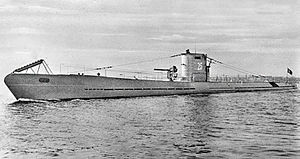 U-25 in about 1936; the number on the conning tower was removed at the beginning of the war
| |
| History | |
|---|---|
| Name | U-25 |
| Ordered | 17 December 1934 |
| Builder | DeSchiMAG AG Weser Bremen |
| Yard number | 903 |
| Laid down | 28 June 1935 |
| Launched | 14 February 1936 |
| Commissioned | 6 April 1936 |
| Fate | Sunk by a British mine around 2 August 1940, in the North Sea north of Terschelling[1] |
| General characteristics [2] | |
| Type | Type IA ocean-going submarine |
| Displacement |
|
| Length | 72.39 m (237 ft 6 in) o/a |
| Beam | 6.21 m (20 ft 4 in) o/a |
| Draught | 4.30 m (14 ft 1 in) |
| Propulsion |
|
| Speed |
|
| Range |
|
| Test depth | 200 m (660 ft) |
| Complement | 4 officers, 39 enlisted |
| Armament |
|
| Service record | |
| Part of: |
|
| Identification codes: | M 10 950 |
| Commanders: |
|
| Operations: |
|
| Victories: | |
German submarine U-25 was one of two Type IA ocean-going submarines produced by Nazi Germany's Kriegsmarine. Constructed by DeSchiMAG AG Weser in Bremen as yard number 903, U-25 was commissioned on 6 April 1936. It experienced a short, but successful combat career, sinking eight ships and damaging one.
- ^ Helgason, Guðmundur. "The Type IA boat U-25". German U-boats of WWII - uboat.net. Retrieved 29 December 2014.
- ^ Gröner 1991, p. 39.